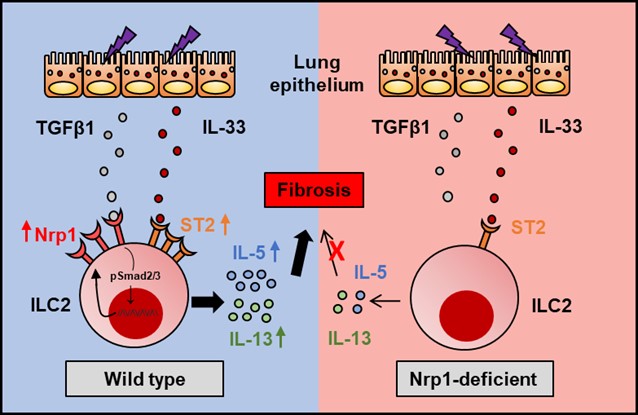Dr. Lei Shen’s group found that Neuropilin-1 marks lung ILC2s and regulates ILC2s activation in pulmonary fibrosis
Source:Lei Shen
2022-03-14
Dr. Lei Shen’s group from Shanghai Institute of Immunology published a research article in Nature Immunology on January 25th, 2022, entitled “Neuropilin-1 mediates lung tissue-specific control of ILC2 function in type 2 immunity”. This study is the first to demonstrate that TGFβ1-induced Neuropilin-1 (Nrp1) specifically marks lung ILC2s and regulates ILC2 activation and the progress of pulmonary fibrosis.
Group 2 Innate Lymphoid Cells (ILC2s) are recently defined tissue-resident innate lymphocytes and they are highly heterogeneous cells based on its location. However, what are the tissue-specific signatures of ILC2s and how these cells integrate into the tissue microenvironment to perform tissue-specific functions remain unclear. Using single cell RNA sequencing and high-parameter flow cytometry, they found that ILC2s exhibited heterogeneity across different tissues, such as lung, intestine, and pancreas. Notably, lung ILC2s specially expressed Nrp1. To answer the questions of how ILC2s acquired Nrp1 expression, they found that Nrp1 was induced postnatally and sustained by lung-derived transforming growth factor beta-1 (TGFβ1). To address what is the functional role Nrp1 in regulating ILC2s, they found that TGFβ1–Nrp1 signaling enhanced ILC2 function by upregulating IL-33 receptor ST2 expression, therefore to accelerate the development of pulmonary fibrosis (Figure). Furthermore, EG00229, a small molecule inhibitor of Nrp1, could significantly reduce pulmonary collagen deposition, slow down the process of pulmonary fibrosis, and decrease the lethality of fibrosis by inhibiting ILC2 function. In accordance with the findings in mice, TGFβ1 induced the expression of NRP1 on human ILC2s. The expression level of Nrp1 on ILC2s from patients with fibrosis was higher than that from patients without fibrosis. Inhibition of Nrp1 with EG00229 suppressed human lung ILC2 activation. These findings lay the groundwork for Nrp1 as a potential therapeutic target of pulmonary fibrosis.

Dr. Jingjing Zhang from Shanghai Institute of Immunology and Dr. Jinxing Qiu from Shanghai Institute of Nutrition and Health are co-first authors. Dr. Lei Shen from Shanghai Institute of Immunology, Dr. Ju Qiu from Shanghai Institute of Nutrition and Health and Dr. Bin He from Shanghai Chest Hospital are co-corresponding authors. This work was funded by grants from the National Key R&D Program of the Ministry of Science and Technology, the National Natural Science Foundation of China, and the Natural Science Foundation of Shanghai.
Links: https://www.nature.com/articles/s41590-021-01097-8
Group 2 Innate Lymphoid Cells (ILC2s) are recently defined tissue-resident innate lymphocytes and they are highly heterogeneous cells based on its location. However, what are the tissue-specific signatures of ILC2s and how these cells integrate into the tissue microenvironment to perform tissue-specific functions remain unclear. Using single cell RNA sequencing and high-parameter flow cytometry, they found that ILC2s exhibited heterogeneity across different tissues, such as lung, intestine, and pancreas. Notably, lung ILC2s specially expressed Nrp1. To answer the questions of how ILC2s acquired Nrp1 expression, they found that Nrp1 was induced postnatally and sustained by lung-derived transforming growth factor beta-1 (TGFβ1). To address what is the functional role Nrp1 in regulating ILC2s, they found that TGFβ1–Nrp1 signaling enhanced ILC2 function by upregulating IL-33 receptor ST2 expression, therefore to accelerate the development of pulmonary fibrosis (Figure). Furthermore, EG00229, a small molecule inhibitor of Nrp1, could significantly reduce pulmonary collagen deposition, slow down the process of pulmonary fibrosis, and decrease the lethality of fibrosis by inhibiting ILC2 function. In accordance with the findings in mice, TGFβ1 induced the expression of NRP1 on human ILC2s. The expression level of Nrp1 on ILC2s from patients with fibrosis was higher than that from patients without fibrosis. Inhibition of Nrp1 with EG00229 suppressed human lung ILC2 activation. These findings lay the groundwork for Nrp1 as a potential therapeutic target of pulmonary fibrosis.

Figure. The model of Nrp1 promoting ILC2 function and accelerating pulmonary fibrosis
Dr. Jingjing Zhang from Shanghai Institute of Immunology and Dr. Jinxing Qiu from Shanghai Institute of Nutrition and Health are co-first authors. Dr. Lei Shen from Shanghai Institute of Immunology, Dr. Ju Qiu from Shanghai Institute of Nutrition and Health and Dr. Bin He from Shanghai Chest Hospital are co-corresponding authors. This work was funded by grants from the National Key R&D Program of the Ministry of Science and Technology, the National Natural Science Foundation of China, and the Natural Science Foundation of Shanghai.
Links: https://www.nature.com/articles/s41590-021-01097-8


